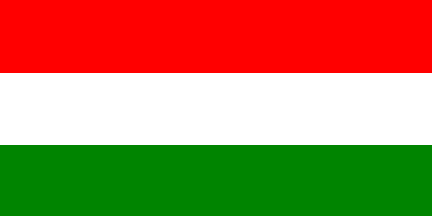.gif)
by Zeljko Heimer, 3 November 2001

Last modified: 2004-10-23 by dov gutterman
Keywords: hungary | cross of lorraine | oak leaves | bent cross | magyar |
Links: FOTW homepage |
search |
disclaimer and copyright |
write us |
mirrors
.gif)
by Zeljko Heimer, 3 November 2001
See also:
The arms of Hungary are: per pale, barry of 8, gules and
argent, gules, a cross lorraine argent, rising out of a crown or
on a compartment vert.
Josh Fruhlinger, 9 April 1996
The crown on the Hungarian arms is the Crown of St. Stephen,
an actual crown that was used to crown the Hungarian kings. In
the 18th century the cross on the crown was bent and since then
it is so depicted on the Hungarian arms.
Nahum Shereshevsky, 11 May 1997
The Lorraine cross appeared as part of the Hungarian Coat of Arms in the 12thCentury as a symbol of the King or of the kingdom (a privilege was grantedby pope Sylvester II to king St. Stephen in 1000 that he may have carried anapostolic (i.e., Lorraine) cross in front of him (hence the title ofHungarian kings, esp. emphasized from Maria Theresia: "N. Dei gratia apostolic king of Hungary"). Back to the Coat of Arms: in or around the movements of 1848, the Slovak nationalist (and/or patriot, depending on the viewpoint) L'udovit Stur created the national symbol of the Slovak people based on his idea that the Lorraine cross and the hill resemble the original Slovak (or, better to say, Great-Moravian) symbols before the Hungarian campaign of the Carpathean basin around 896. In fact, there is a legend which appeared in the cod